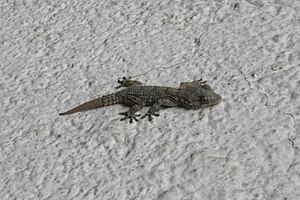Canarian wall gecko
| Canarian wall gecko | ||||||||||||
|---|---|---|---|---|---|---|---|---|---|---|---|---|

Canarian wall gecko ( Tarentola angustimentalis ) |
||||||||||||
| Systematics | ||||||||||||
|
||||||||||||
| Scientific name | ||||||||||||
| Tarentola angustimentalis | ||||||||||||
| Steindachner , 1891 |
The Canary Wall Gecko ( Tarentola angustimentalis ) is a species of gecko from the family Phyllodactylidae . It is endemic to some of the islands in the eastern Canary Islands .
features
The Canary Wall Gecko is one of the largest species of gecko found in the Canary Islands. It reaches a total length of up to 160 millimeters. Its head-torso length is up to 77 millimeters in males and up to 64 millimeters in females. The species can also grow larger under terrarium conditions. The basic color of the top of the body is gray to pale cream or dark brown. Due to the color change typical of Canarian gecko species, the Canary Wall geckos are almost black during the day in the sun, while they are very light to white-gray at night. Showy dark brown cross bars are separated from each other by light spots. On the upper side of the tail there are dark and light transverse bands, provided that it has not yet been regenerated. The iris is colored gold-metallic-brown. The body is flattened. The head is clearly set off, narrow and has a slender muzzle. Due to the relatively long limbs, the species looks long-legged.
Occurrence
The species occurs only on the Canary Islands Fuerteventura , Lanzarote and the offshore islands of Lobos , La Graciosa , Montaña Clara , Roque del Oeste , Roque del Este and Alegranza .
The Canary Wall Gecko lives on these islands at all altitudes. It can mostly be found on the ground and under stones, but can also be found in bushes. Areas he avoids are pure dunes and young lava fields. In the same habitat as the Canary Wall Gecko, the Eastern Canarian Lizard ( Gallotia atlantica ) and on Fuerteventura also the Purpurarium Skink ( Chalcides simonyi ) can be found.
Way of life
The species is diurnal and nocturnal. The mating season begins in March. The mating behavior of the species as well as audible sounds are very similar to that of the wall gecko ( Tarentola mauritanica ). Pregnant females can be found from mid-May to mid-July. The clutches are buried in the sand. They usually contain two eggs each, but often only one in young females. The Canary Wall gecko's diet consists of insects, woodlice, spiders and other small animals. The barn owl ( Tyto alba ) is an important predator . Other predators may include the wandering hedgehog ( Atelerix algirus ) or stray cats and dogs.
Systematics
The Canary Wall Gecko was originally described as a variety of the Wall Gecko, as both have a certain similarity. The epithet angustimentalis refers to the slender chin shield ( mental , on the underside of the head the foremost larger unpaired shield). No subspecies are distinguished.
supporting documents
- Dieter Glandt : Pocket dictionary of amphibians and reptiles in Europe. All types from the Canary Islands to the Urals. Quelle & Meyer, Wiebelsheim 2010, ISBN 978-3-494-01470-8 , pp. 534-536.
Web links
- Tarentola angustimentalis inthe IUCN 2013 Red List of Threatened Species . Posted by: Jose Antonio Mateo Miras, Valentin Pérez-Mellado, Iñigo Martínez-Solano, 2008. Retrieved January 30, 2014.
- Tarentola angustimentalis in The Reptile Database
